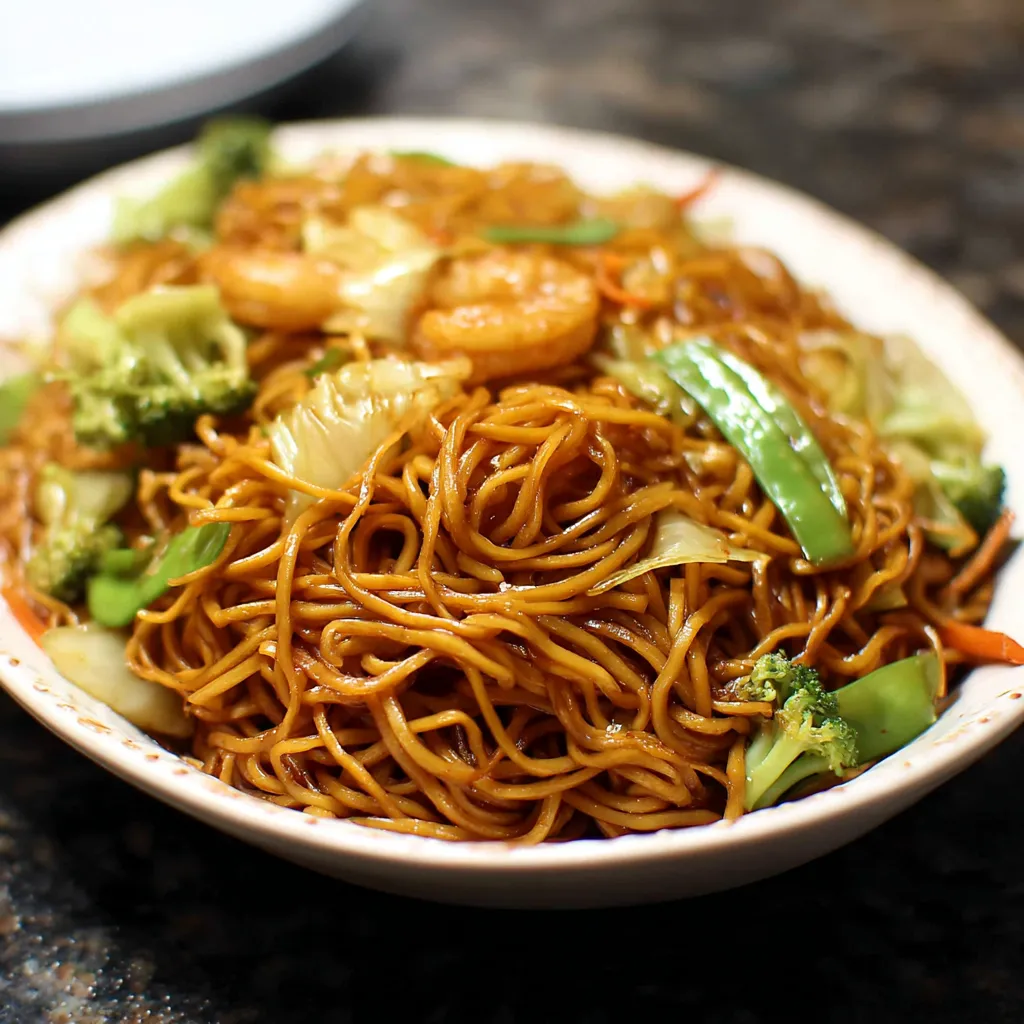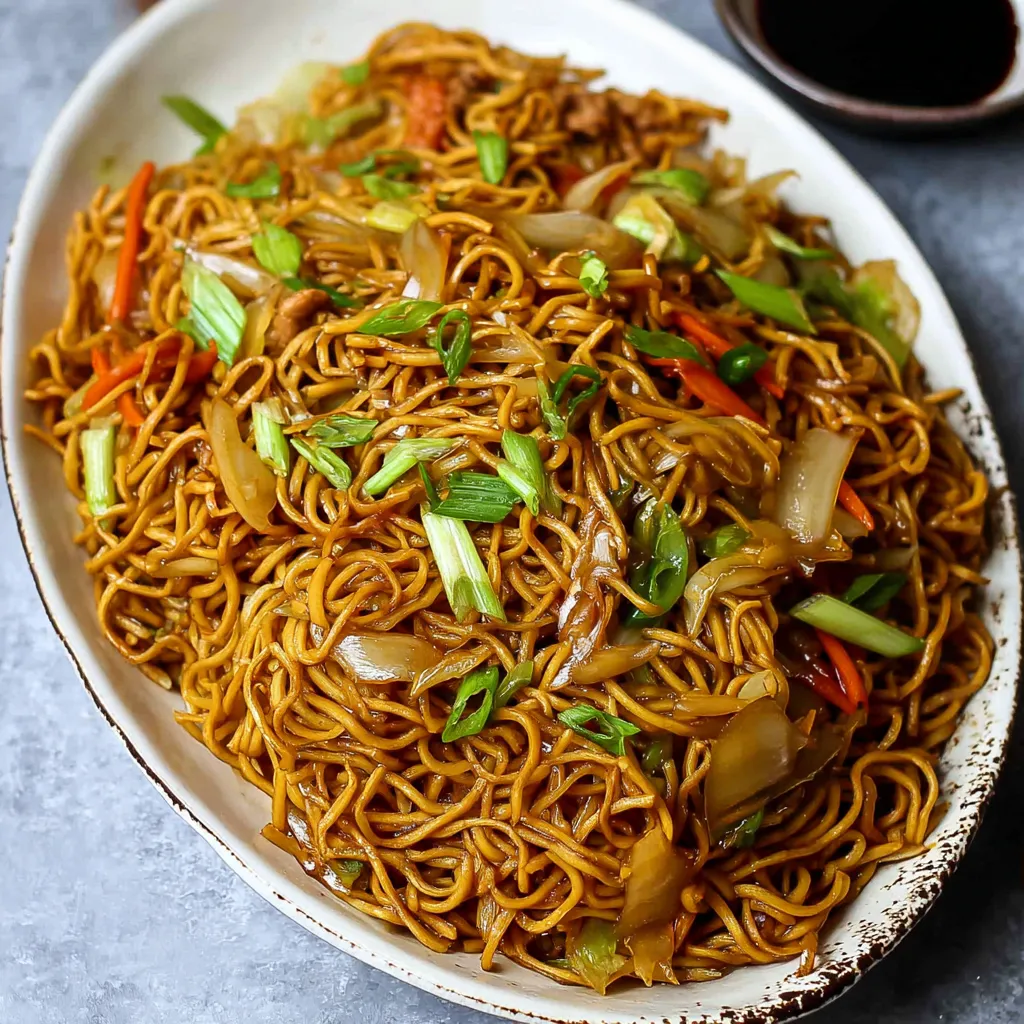 Bookmark
Bookmark
This hearty Panda Express Chow Mein copycat recipe brings authentic Asian flavors to your kitchen in just 15 minutes. The perfect balance of chewy noodles, crunchy vegetables, and savory sauce makes this dish impossible to resist as a side or main meal.
I discovered this recipe during a busy weeknight when my family was craving takeout. After perfecting this version, my children now request it weekly instead of the restaurant version, which saves us money and tastes even better.
Ingredients
- Chow mein noodles use fresh varieties for authentic texture and quicker cooking time
- Cabbage adds essential crunch and subtle sweetness when cooked briefly
- Celery provides texture contrast and a light peppery note
- Onion creates aromatic foundation and caramelizes slightly for depth
- Vegetable oil keeps noodles from sticking and helps vegetables cook evenly
- Regular soy sauce brings umami and saltiness to the sauce base
- Dark soy sauce adds rich color and deeper flavor than regular soy alone
- Oyster sauce creates authentic restaurant quality flavor with its complex sweetness
- Sesame oil finishes the dish with nutty aroma that defines Asian noodle dishes
- Fresh garlic cloves add pungent flavor that mellows beautifully when cooked
- Chicken stock creates depth in the sauce better than water alone
- Cornstarch thickens the sauce ensuring it clings perfectly to every noodle
Step-by-Step Instructions
- Prepare The Sauce
- Combine soy sauces, oyster sauce, sesame oil, minced garlic, chicken stock and cornstarch in a small bowl. Whisk until cornstarch is completely dissolved with no lumps remaining. The sauce should have a medium thickness and glossy appearance.
- Blanch The Noodles
- Bring a large pan of water to a rolling boil over medium high heat. Add the fresh chow mein noodles and cook for exactly 20 30 seconds. Watch carefully as overcooking will make them mushy. The noodles should become just pliable but still have bite to them.
- Drain Properly
- Immediately transfer noodles to a colander and drain thoroughly. Do not rinse with water as this removes starches that help the sauce adhere. Give the colander a few shakes to remove excess water which would dilute your sauce.
- Stir Fry Vegetables
- Heat 1 tablespoon of vegetable oil in a large pan or wok until shimmering. Add sliced onions, cabbage and celery. Stir fry continuously for about 1 minute until vegetables just begin to soften but still maintain crispness. The cabbage should wilt slightly but still have texture.
- Combine Everything
- Push vegetables to one side of the pan creating an empty space. Add the remaining tablespoon of oil to this empty area and immediately add your blanched noodles. Pour the prepared sauce directly over the noodles.
- Final Toss
- Using tongs or two utensils, toss everything together with quick motions until all noodles are evenly coated with sauce and vegetables are distributed throughout. The sauce will thicken slightly as it heats through. Remove from heat once everything is well combined to prevent overcooking.

The dark soy sauce is my secret ingredient that most copycat recipes miss. It gives these noodles their distinctive color and depth that makes them instantly recognizable as Panda Express style. My daughter noticed immediately when I tried making them without it once, proving its importance to achieving authentic flavor.
Storage Tips
These noodles keep beautifully in airtight containers in the refrigerator for up to 3 days. The flavor actually improves overnight as the noodles absorb more of the sauce. When reheating, add a splash of water and stir fry quickly over medium high heat until just heated through. Avoid microwaving as it can make the noodles soggy and the vegetables limp.
Perfect Pairings
This chow mein works wonderfully alongside orange chicken or beef and broccoli for a complete takeout style meal at home. For a lighter option, serve with steamed vegetables or a simple cucumber salad dressed with rice vinegar. During summer months, I often add a side of cold sesame noodles for a refreshing contrast to the warm chow mein.
Customization Ideas
While this recipe perfectly recreates the Panda Express classic, you can easily customize it to your preferences. Add bean sprouts or thinly sliced bell peppers for extra crunch and nutrition. For protein, stir in cooked chicken, shrimp, or scrambled eggs during the final minute of cooking. Vegetarians can substitute vegetarian stir fry sauce for the oyster sauce and use vegetable stock instead of chicken stock without losing flavor.
Common Recipe Questions
- → What type of noodles should I use for chow mein?
For authentic chow mein, use fresh Chinese egg noodles labeled as 'chow mein noodles' or 'steamed noodles' in Asian markets. These have a yellow color and slightly chewy texture. In a pinch, you can substitute with dried Chinese egg noodles, though the texture will be slightly different. Avoid using rice noodles or spaghetti as they won't provide the characteristic chew and flavor.
- → Can I make this dish vegetarian?
Yes! To make this dish vegetarian, simply substitute the chicken stock with vegetable stock or water, and replace the oyster sauce with vegetarian stir-fry sauce or vegetarian oyster sauce (made from mushrooms). The rest of the ingredients are already plant-based, making this an easy adaptation that maintains the authentic flavor profile.
- → What protein goes well with chow mein?
Chow mein pairs wonderfully with many proteins. Traditional options include chicken, beef, shrimp, or char siu (Chinese BBQ pork). For a vegetarian version, try adding tofu, tempeh, or seitan. You can either stir-fry your protein separately and add it at the end, or cook it in the same pan before adding the vegetables to build more flavor.
- → Why is dark soy sauce used in addition to regular soy sauce?
Dark soy sauce adds both color and a deeper, less salty flavor to the dish. It helps create the characteristic caramel-brown color of authentic chow mein without making it too salty. If you don't have dark soy sauce, you can use all regular soy sauce, but the color will be lighter and you might want to add a pinch of sugar to balance the saltiness.
- → How do I store leftover chow mein?
Store leftover chow mein in an airtight container in the refrigerator for up to 3 days. To reheat, add a small splash of water before microwaving to help rehydrate the noodles, or quickly stir-fry in a hot pan with a little oil. The texture is best when fresh, but leftovers still make a delicious quick meal.
- → What's the difference between chow mein and lo mein?
The main difference is in the cooking method. Chow mein noodles are stir-fried until they develop a slight crispness, while lo mein noodles are fully cooked and then tossed with sauce and other ingredients without additional frying. Chow mein typically has a lighter sauce coating each strand, while lo mein has more sauce that pools at the bottom of the dish.
